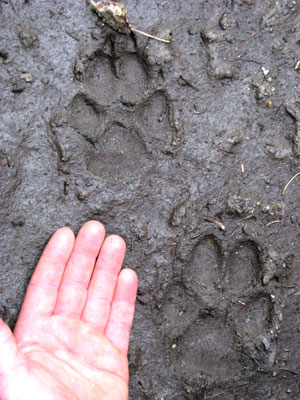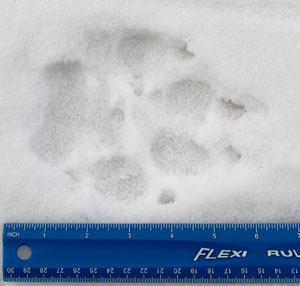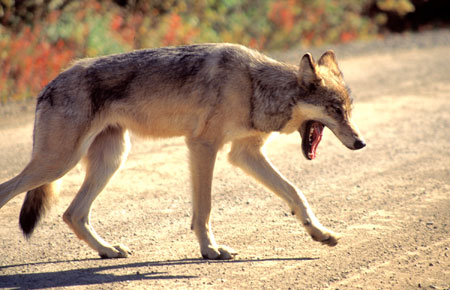Wolf
(Canis lupus)
Printer Friendly
Did You Know?
There are 7,000 to 11,000 wolves in Alaska.
General Description
Wolves are members of the family Canidae. Early taxonomists recognized about 24 New World and eight Old World subspecies of Canis lupus, with four subspecies thought to occur in Alaska. Recent studies of skull characteristics, body size, and color suggest that differences are slight with considerable overlap in the characteristics of wolves from various areas. Only two Alaska subspecies are now recognized. Wolves in Southeast Alaska tend to be darker and somewhat smaller than those in northern parts of the state. The pelt color of Alaska wolves ranges from black to nearly white, with every shade of gray and tan in between. Gray or black wolves are most common, and the relative abundance of each color phase varies over time and from place to place.
Most adult male wolves in Interior Alaska weigh from 85 to 115 pounds (38.6-52.3), but they occasionally reach 145 pounds (65.3 kg). Females average 10 to 15 pounds (2-5 kg) lighter than males and rarely weigh more than 110 pounds (50 kg). Wolves reach adult size by about 1 year of age.
Life History
Wolves are social animals and usually live in packs that include parents and pups of the year. The average pack size is six or seven animals, and pack members often include some yearlings and other adults. Packs of 20 to 30 wolves sometimes occur, and these larger packs may have two or three litters of pups from more than one female.
The social order in the pack is characterized by a separate dominance hierarchy among females and males. In most areas wolf packs tend to remain within a territory used almost exclusively by pack members, with only occasional overlap in the ranges of neighboring packs.
Despite a generally high birth rate, wolves rarely become abundant because mortality is also high. In much of Alaska, the major sources of mortality are: predation by other wolves; hunting; and trapping. Diseases, malnutrition, and accidents also help regulate wolf numbers. Predation by other wolves is a major cause of death because wolves defend their territories from other wolves. Dispersing wolves (e.g., young adults) are common but they typically find little suitable habitat that is not already occupied by other wolves.
Reproduction
Typically one female wolf in a pack has a litter of about seven pups each year. This varies, in some packs more than one female may bring off a litter.
In some cases a pair of wolves may not form a pack or belong to a pack, and will bring off a litter of pups.
Diet
Wolves are carnivores, and in most of mainland Alaska moose and/or caribou are their primary food, with Dall sheep, squirrels, snowshoe hares, beaver, and occasionally birds and fish as supplements in the diet. The rate at which wolves kill large mammals varies with prey availability and environmental conditions. A pack may kill a deer or moose every few days during the winter. At other times, they may go for several days with almost no food. Since wolves are opportunistic, young, old, or debilitated animals are preyed upon more heavily than healthy middle-age animals. Under some circumstances, however, such as when snow is unusually deep or prey is scarce, even animals in their prime may be vulnerable to wolves.
In Southeast Alaska, Sitka black-tailed deer, mountain goats, and beaver are the most important sources of food. Research indicates that salmon are important seasonally where they are available, especially to young wolves. During summer, small mammals including voles, lemmings and ground squirrels are taken. Wolves also scavenge, and coastal wolves will beach comb.
Range and Habitat
The wolf occurs throughout mainland Alaska, on Unimak Island in the Aleutians, and on all of the major islands in Southeast except Admiralty, Baranof, and Chichagof. This range includes about 85 percent of Alaska's 586,000 square-mile area. Wolves are adaptable and exist in a wide variety of habitats extending from the rain forests of the Southeast Panhandle to the arctic tundra along the Beaufort Sea. Alaska is home to an estimated 7,000 to 11,000 wolves. Wolves have never been threatened or endangered in Alaska. They are found in nearly all of their historic range, excepting the center of urban areas, although they are found on the outskirts of Anchorage, Fairbanks and Juneau. Wolves are common over much of the state. The highest densities occur in Southeast Alaska, where Sitka black-tailed deer serve as the major food source for wolves. Wolf densities are lowest in the coastal portions of western and northern Alaska. Although the distribution of wolves has remained relatively constant in recent times, their abundance is influenced by harvest levels, diseases, and prey availability
Genetic evidence suggests that as Alaska deglaciated following the most recent glacial maximum and animals colonized the newly exposed areas, wolves from the contiguous Western United States entered Southeast Alaska, likely following the northward expansion of black-tailed deer along the coast. Wolves in Interior Alaska are likely descended from animals that inhabited Beringia during the ice age, and wolves in Southeast are genetically distinctive from "continental" wolves.
Status, Trends, and Threats
Status
Alaska is home to an estimated 7,000 to 11,000 wolves. Wolves have never been threatened or endangered in Alaska. The food habits of the wolf often bring it into conflict with humans who in many parts of the world are also hunters of big game animals. Although the wolf has coexisted with big game animals for thousands of years, under some conditions the impact of predation contributes to local scarcities of game which arouse some people's concern. In most non-coastal systems with moose and caribou, wolves and bears together maintain game populations below levels at which their food supply would be damaged.
Various studies of wolf ecology have shown that the balance between wolf and prey populations can be disrupted. For example, severe winters in combination with wolf and bear predation can drastically reduce a big game population. Because many of Alaska's big game populations and their habitats are less productive than those in lower latitudes and because predators such as wolves and bears are common here, human hunters have to limit their harvest in many areas. In some areas wolf numbers may need to be controlled in order to avoid relatively long periods of prey scarcity which could result in little or no harvest for people and also low numbers of wolves and other furbearers.
Wolves are often seen and heard in most parts of Alaska by those willing to spend time in remote areas. The long term future of the wolf in Alaska is secure, and Alaska will probably continue to deal with the challenges related to the effects of wolf predation on big game populations for a long time.
GMU 2 Wolf Population Estimate Update – Fall 2014 Memorandum (PDF 292 kB)
The Status and Outlook of Southeast Alaska's Unit 2 Wolves — 2014 (PDF 1,105 kB) is a 2014 publication highlighting recent research, population status and harvest guidelines, and management and research plans. It focuses on Unit 2, primarily Prince of Wales Island and neighboring Dall Island to the west. It is six pages in length, with one map.
Status of Wolves in Southeast Alaska — 2012 (PDF 57 kB) is a nine-page overview of the coastal wolves of the Alexander Archipelago. It summarizes past and current research including population ecology, taxonomy, current management considerations and the relevance of the Tongass Land Management Plan and the Endangered Species Act.
Fast Facts
-
Remarks
Alaska is home to an estimated 7,000 to 11,000 wolves. Wolves have never been threatened or endangered in Alaska. -
Other names
Grey wolf, timber wolf.
Did You Know?
- Predation by other wolves is a major cause of death for wolves because wolves defend their territories.
- There are 7,000 to 11,000 wolves in Alaska.
- Where salmon are available, they are an important seasonal food source for wolves in some areas, and are especially important to pups.
Uses
Wolves in Alaska are managed as both a big game animal and a furbearer; they are hunted and also trapped. Each year, hunters and trappers harvest about 1,300 wolves in the state, with up to an additional 200 animals or so taken annually via intensive management (predator control) programs. As with all furs, the prices paid for wolf pelts vary from year to year. All harvested wolves must be taken to an Alaska Department of Fish and Game or representative office for “sealing,” a process in which the hide is examined, recorded and a tag or seal is affixed.
Wolves are also valued intrinsically. They represent a spirit of wildness, wilderness, and something quintessentially Alaskan to many people. Although they are very difficult to view because of their elusive behavior, wildlife watchers cherish the occasional sightings. Sightings are more common in parks such as Denali.
Research
Wolves are the subject of a great deal of research related to predator prey dynamics. See Intensive Management in Alaska for more information.
Citizen Science Opportunities
More Resources
General Information
- Wolf Trails Newsletter, Winter 2024 edition (PDF 454 kB)
- Wolf Trails of Southeast Alaska, 2023 (PDF 862 kB)
- Wolf — Wildlife Notebook Series (PDF 45 kB)
Wolf Safety
- Living With Wolves
- Wolf Safety Brochure (PDF 329 kB)
Game Unit 2 Survey Memos
- GMU 2 Wolf Population Estimate — 2023 Memorandum (PDF 270 kB)
- GMU 2 Wolf Population Estimate — 2022 Memorandum (PDF 241 kB)
- GMU 2 Wolf Population Estimate — 2021 Memorandum (PDF 323 kB)
- GMU 2 Wolf Population Estimate — 2020 Memorandum (PDF 264 kB)
- GMU 2 Wolf Population Estimate — 2019 Memorandum (PDF 407 kB)
- GMU 2 Wolf Population Estimate — 2018 Memorandum (PDF 360 kB)
- GMU 2 Wolf Population Estimate — 2017 Memorandum (PDF 370 kB)
- GMU 2 Wolf Population Estimate — 2016 Memorandum (PDF 499 kB)
- GMU 2 Wolf Population Estimate — 2015 Memorandum (PDF 773 kB)
- GMU 2 Wolf Population Estimate — 2014 Memorandum (PDF 413 kB)
Wildlife Viewing
Management & Research Reports
Additional Links
- Video: Managing Predators and Prey in Alaska (5 segments of about 6 minutes each)
- The Alexander Archipelago Wolf
- Helping Wolves in Interior Alaska (Alaska Wildlife News article)
- Predator Management in Alaska
- Big Wolves and Ordinary Wolves — Wolf Weight Depends on When and What They Eat
- Snow Machines, Trails and Wolves

Wolf Tracks



